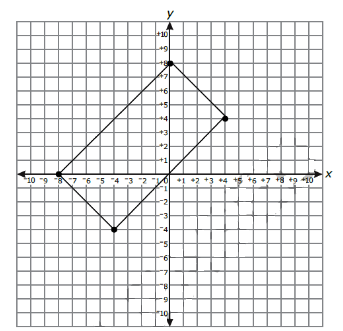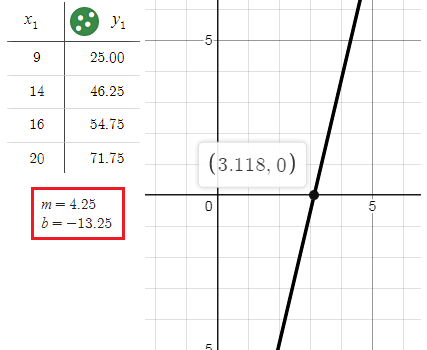MATH 1 PRACTICE TEST EOC WITH SOLUTIONS
Problem 31 :
The graph below shows the amount of profit, y, a company makes from selling x units of merchandise.

How many units of merchandise does the company need to sell to make the maximum profit?
A. 100 B. 300 C. 500
Problem 32 :
The quadrilateral shown below has vertices at (-8, 0), (-4, -4), (0, 8) and (4, 4).

What is the area of the quadrilateral?
A. 32 units2 B. 45 units2
C. 64 units2
Solution:
By using Pythagorean Theorem,
|
To find length : l2 = 82 + 82 l2 = 64 + 64 l2 = 128 l = 8√2 |
To find width: w2 = 42 + 42 w2 = 16 + 16 w2 = 32 w = 4√2 |
area of the quadrilateral = length × width
= 8√2 × 4√2
= 32(2)
= 64 units2
Problem 33 :
Which equation has a graph which is perpendicular to the line y = -2x and which passes through the point (-2, 3)?
A. x - 2y = 8 B. x + 2y = -8 C. x - 2y = -8
Solution:
The slope of the line that is perpendicular to y = -2x
m = 1/2
y = mx + b
Substitute (-2, 3) for (x, y) in above equation,
3 = (1/2)(-2) + b
3 = -1 + b
b = 4
y = (1/2)x + 4
2y = x + 8
x - 2y = -8
So, option (C) is correct.
Problem 34 :
The cost to mail a box of textbooks can be modeled by the function f(x) = 1.75x + 5.25, where x is the number of books mailed. What does the y-intercept of the function represent?
A. the cost to mail a box with no textbooks
B. the number of books mailed
C. the cost per book
Solution:
f(x) = 1.75x + 5.25
When x = 0,
f(x) = 1.75(0) + 5.25
= 0 + 5.25
f(x) = 5.25 (x = 0, no book)
5.25 is the y-intercept.
So, it represent the cost of mail a box with no text books.
So, option (A) is correct.
Problem 35 :
Which situation could be best modeled with an exponential function?
A. the value of a car that loses 6% of its value per year.
B. the cost to purchase different weights of bananas at a store.
C. the total number of miles run by a person who runs 8 miles per day.
Solution:
A.
Assuming the future value = P(1 - 6%)t
it is exponential function.
C.
Total = 8 miles per day
It is linear function.
So, option (A) is correct.
Problem 36 :
The function f(x) = 4(2.0)x models the population of rabbits on a farm after x months with no removal. The function g(x) = 2(2.0)x models the number of rabbits removed from the population after x months. Which function, h(x), ,models the total number of rabbits on the farm after x months?
A. h(x) = 2(1.0)x B. h(x) = 2(2.0)x C. h(x) = 6(2.0)x
Solution:
Given, f(x) = 4(2.0)x
g(x) = 2(2.0)x
h(x) = f(x) - g(x)
= 4(2.0)x - 2(2.0)x
= (2.0)x[4 - 2]
h(x) = 2(2.0)x
So, option (B) is correct.
Problem 37 :
Fred has $200. Each week he will save an additional $50. If Fred does not spend any of the money, how many weeks will it take for Fred to have $650?
A. 9 B. 13 C. 17
Solution:
50x + 200 = 650
50x = 650 - 200
50x = 450
x = 9
It will take 9 weeks.
So, option (A) is correct.
Problem 38 :
Solution:
So, option (B) is correct.
Problem 39 :
The table below shows the cost of a season ticket to an amusement park for various years.

What is represented by the y-intercept of the line of best fit for this data set?
A. the predicted average change in ticket price per year.
B. the predicted number of years per $1 increase in ticket price.
C. the predicted price of a ticket in 1990.
Solution:

y = mx + b
y = 4.25x - 13.25
The predicted price of a ticket in 1990.
So, option (C) is correct.
Problem 40 :
Kerry wants to simplify the following:
Which of the following is the correct result?
A. 4x B. 4x + 1 C. 20x2 D. 20x2 + 1
Solution:
So, option (B) is correct.
Recent Articles
-
Finding Range of Values Inequality Problems
May 21, 24 08:51 PM
Finding Range of Values Inequality Problems -
Solving Two Step Inequality Word Problems
May 21, 24 08:51 AM
Solving Two Step Inequality Word Problems -
Exponential Function Context and Data Modeling
May 20, 24 10:45 PM
Exponential Function Context and Data Modeling